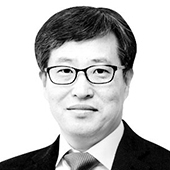Reform pensions to solve senior poverty

Lee Hyun-sang
The author is a senior editorial writer at the JoongAng Ilbo.
In Korea, being old is a shame. Looking young is a compliment, and clothing and cosmetics that make old people young are popular. Noin, the Korean word for the elderly, has become taboo.
What makes being old more shameful is poverty. Nearly 40 percent of elderly Koreans aged 65 or older belong to the relatively poor class, living on less than half the median income. That percentage is three times the OECD average of 13.5 percent in 2019.
This is actually an improvement after the basic pension for the elderly was introduced for seniors in the bottom 70 percent of income. While Korea is ranked high in many economic indicators, the elderly are left with shameful statistics.
However, their present is the future of the young generation. The relative poverty rate of those aged 66 and older in Korea is 40.4 percent, nearly four times the 10.6 percent poverty rate for people between 18 and 65. The gap is far higher than other developed countries such as Switzerland and Australia. That means young Koreans are more likely to become poor when they grow old.
What I want to say is that the income replacement rate of our national pension should be higher. Now, the nominal income replacement ratio is 42.5 percent. The ratio has been lowered each year to delay the depletion of the pension fund, and will hit 40 percent by 2028. But if you think someone who earns a monthly income of 4 million won ($3,172) will get 1.6 million in pension, you are mistaken. The actual payment is about half that. The nominal replacement ratio is based on 40 years of subscription, but the average subscription period is only 18.7 years. That’s why the actual replacement rate shrinks to approximately 22 percent.
Two major issues being discussed at the National Assembly’s Special Committee on Pension Reform are the premium rate and the replacement ratio. A consensus seems to be converging into raising the premium rate currently fixed at 9 percent. But opinions on the replacement rate are quite mixed. A civilian advisory board came up with two options — maintaining the current replacement ratio or raising it — after failing to narrow differences.
According to a projection regarding the national pension fund, the average subscription period for new recipients will still be 27 years on average by 2080. In this case, the actual income replacement ratio is calculated to be 23 percent to 24 percent. Of course, people who are well off will make a triple plan for the national pension, retirement pension and personal pension. But those who cannot afford the other two will have to settle for the “allowance pension.”
In that case, our pitiful poverty rate of the elderly cannot be improved. Recently, the National Pension Service presented the gloomy prospect that the elderly poverty rate will remain at 29.8 percent in 2085, when the children born in 2020 become seniors. Without raising the actual replacement rate, the future generation of Koreans will likely keep the shameful title, “the country with the poorest elderly in the world.”
The biggest reason for young people not having children is the uncertainty about the future. If their stable senior years are not guaranteed no matter how hard they work, who would spend money for their children? The pension reform is aimed at delaying the fiscal depletion and making people have confidence in public pensions. But even if the depletion is delayed, the pension will run out someday. If the focus is placed on delaying the timing and “small pension payments” continues, people will lose trust in the pension system itself.
A short-sighted view is to consider the expanded function of public pension as a social burden. From 2060, senior citizens will make up more than 45 percent of the entire population. If nearly half the population suffers from poverty, the Korean economy cannot but fall into a vicious cycle of contraction. We must seriously study effective ways to enhance the replacement ratio even if it means both raising the premium rate and delaying the age eligible to receive the pension.
If the high poverty rate of the elderly continues, our society will suffer from more polarization and consequent discord. As senior voters’ demand for public assistance grows stronger, financial pressure will mount. After the basic pension for the elderly in the lower income bracket was first introduced in 2008, the payment increased by about 100,000 won a month whenever the administration changed. The Yoon Suk Yeol administration already promised to raise the basic pension to 400,000 won from the current 300,000 within his term. Rather than repeating this stupid cycle, it could be better to reach a social consensus on lifting the replacement ratio of the national pension.
It will not be easy given many challenges such as extending the retirement age, increasing jobs for the elderly, and adjusting our welfare system. But we cannot wait for a gloomy future. We can also consider feasible ways to reorganize cash handouts and use the money to fund the national pension. Old age is the only thing you can gain without effort, but happiness in old age cannot be attained without effort. If that effort is solely left to individuals, what does the country exist for?










with the Korea JoongAng Daily
To write comments, please log in to one of the accounts.
Standards Board Policy (0/250자)